Home » Upper atmosphere physics
Category Archives: Upper atmosphere physics
Current state and perspectives of Space Weather science in Italy
Papers from SWICo members
Plainaki Christina, Antonucci Marco, Bemporad Alessandro, Berrilli Francesco, Bertucci Bruna, Castronuovo Marco, De Michelis Paola, Giardino Marco, Iuppa Roberto, Laurenza Monica, Marcucci Federica, Messerotti Mauro, Narici Livio, Negri Barbara, Nozzoli Francesco, Orsini Stefano, Romano Vincenzo, Cavallini Enrico, Polenta Gianluca, Ippolito Alessandro
This paper presents a brief state-of-the-art in Space Weather science in Italy and discuss some ideas on a long-term plan for the support of future scientific research in the related disciplines. Italian teams contributed in the advancing of our knowledge on the properties and evolution of the Space Weather phenomena with observational campaigns from space and from the ground. Numerous Space Weather forecasting and now-casting modeling efforts have resulted in a remarkable add-on to the overall progress in the field, at both national and international level. The Italian Space Agency participated several times in space missions related to Space Weather; indeed, the development of new instrumentation for future Heliophysics and Space Weather space missions will be very important for the Italian scientific and industrial communities.
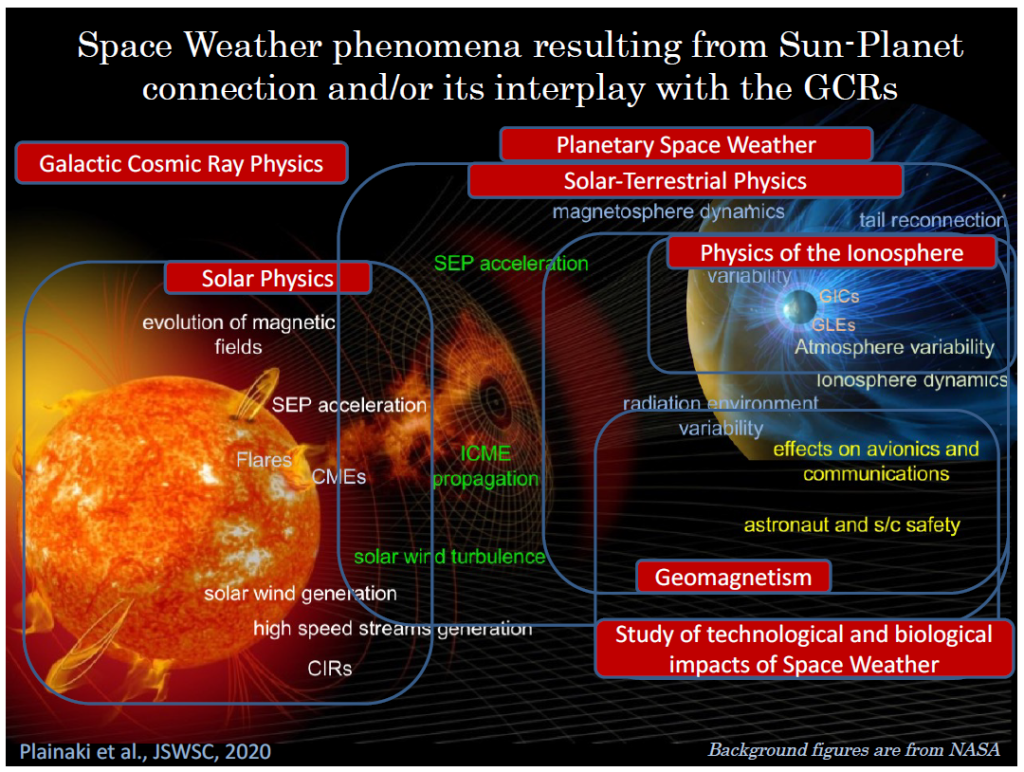
The Italian Space Agency aims to assess the possibility to develop a national scientific Space Weather data centre to encourage synergies between different science teams with interest in the field and to motivate innovation and new mission concept development. Alongside with the proposed recommendations, this paper also discusses how the Italian expertise could complement international efforts in a wider international Space Weather context.
Publication: Plainaki C., Antonucci M., Bemporad A., Berrilli F., Bertucci B., Castronuovo M., De Michelis P., et al., 2020, JSWSC, 10, 6. doi:10.1051/swsc/2020003. https://www.swsc-journal.org/articles/swsc/abs/2020/01/swsc190014/swsc190014.html
Can an impulsive variation of the solar wind plasma pressure trigger a plasma bubble? A case study based on CSES, Swarm and THEMIS data
Papers from SWICo members
M. Piersanti, M. Pezzopane, Z. Zhima, P. Diego, C. Xiong, R. Tozzi, A. Pignalberi, G. D’Angelo, R. Battiston, J. Huang, P. Picozza, Y. Rui, X. Shen, R. Sparvoli, P. Ubertini, Y. Yang, S. Zoffoli
During the August 25, 2018 geomagnetic storm, the new borne CSES-01 satellite and the Swarm A satellite detected a really large equatorial plasma bubble (EPB) in the post-midnight sector over western Africa. We investigated the features of this deep ionospheric plasma depletion using data from the Langmuir probes on-board CSES-01 and Swarm A satellites, and data from the high-precision magnetometer and the electric field detector instruments on-board CSES-01. Using also plasma and magnetic field data from THEMIS-E satellite we found that, during the passage of the magnetic cloud that drove the geomagnetic storm, an impulsive variation lasting about ten minutes characterized the solar wind (SW) pressure.
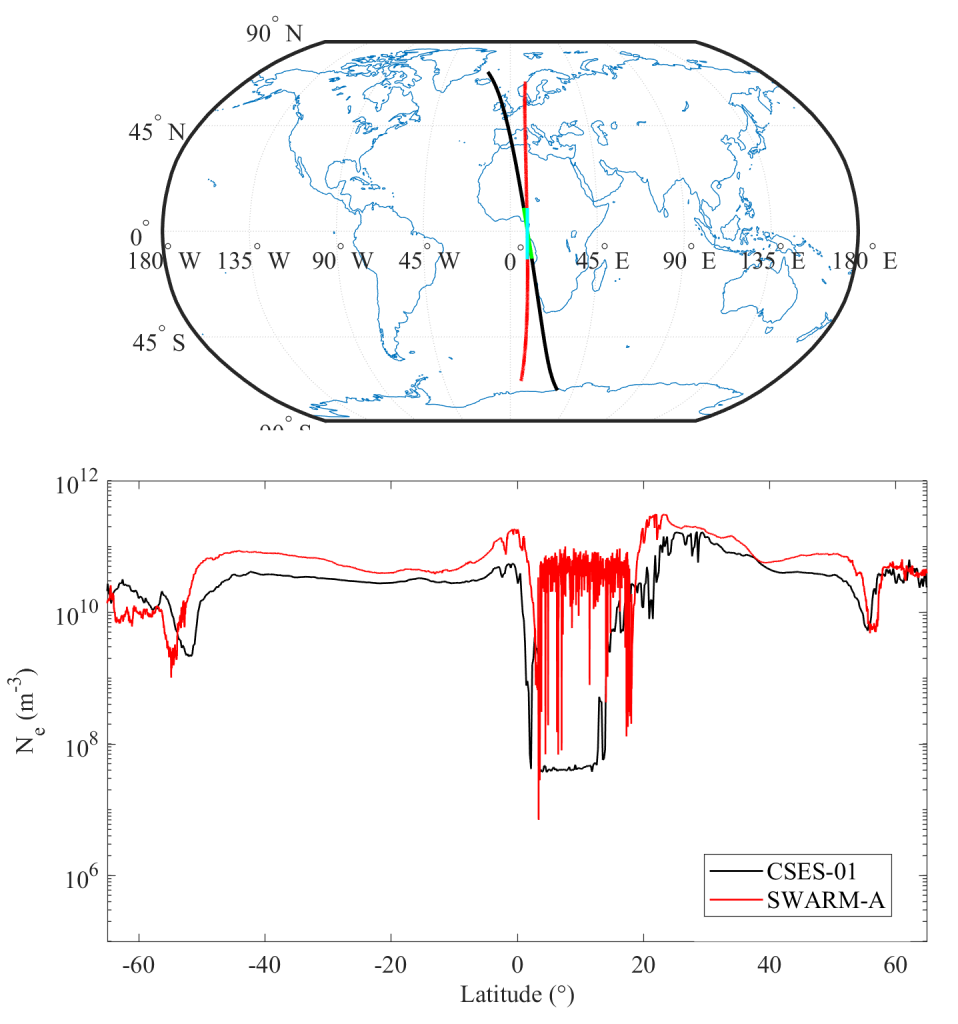
The analysis of the delay time, between the occurrence of such impulsive variation and the detection of the plasma bubble, suggests a possible link between the SW pressure impulsive variation as identified by THEMIS-E and the generation of the EPB as detected by CSES-01 and Swarm A. We put forward the hypothesis that the SW pressure impulsive variation might have triggered an eastward prompt penetrating electric field that propagated from high to equatorial latitudes, overlapping in the nightside region to the zonal westward electric field, causing either a reduction or an inversion, at the base of the EPB triggering.
Publication: M. Piersanti, M. Pezzopane, Z. Zhima et al., Can an impulsive variation of the solar wind plasma pressure trigger a plasma bubble? A case study based on CSES, Swarm and THEMIS data, Advances in Space Research 67, 35–45, 2021. https://doi.org/10.1016/j.asr.2020.07.046
The Great Aurora of 4 February 1872 observed by Angelo Secchi in Rome
Papers from SWICo members
Francesco Berrilli, Luca Giovannelli
On February 4, 1872, exactly 150 years ago, a great aurora was observed over a vast extent of the Earth. The aurora was also observed in Rome. In a pioneering work by Angelo Secchi, then director of the Observatory of the Roman College, there is the description of the multi-instrument observations carried out in Rome. An avant-garde work that describes what today we call an extreme event of Space Weather, an event with consequences on technological infrastructures on a planetary scale.
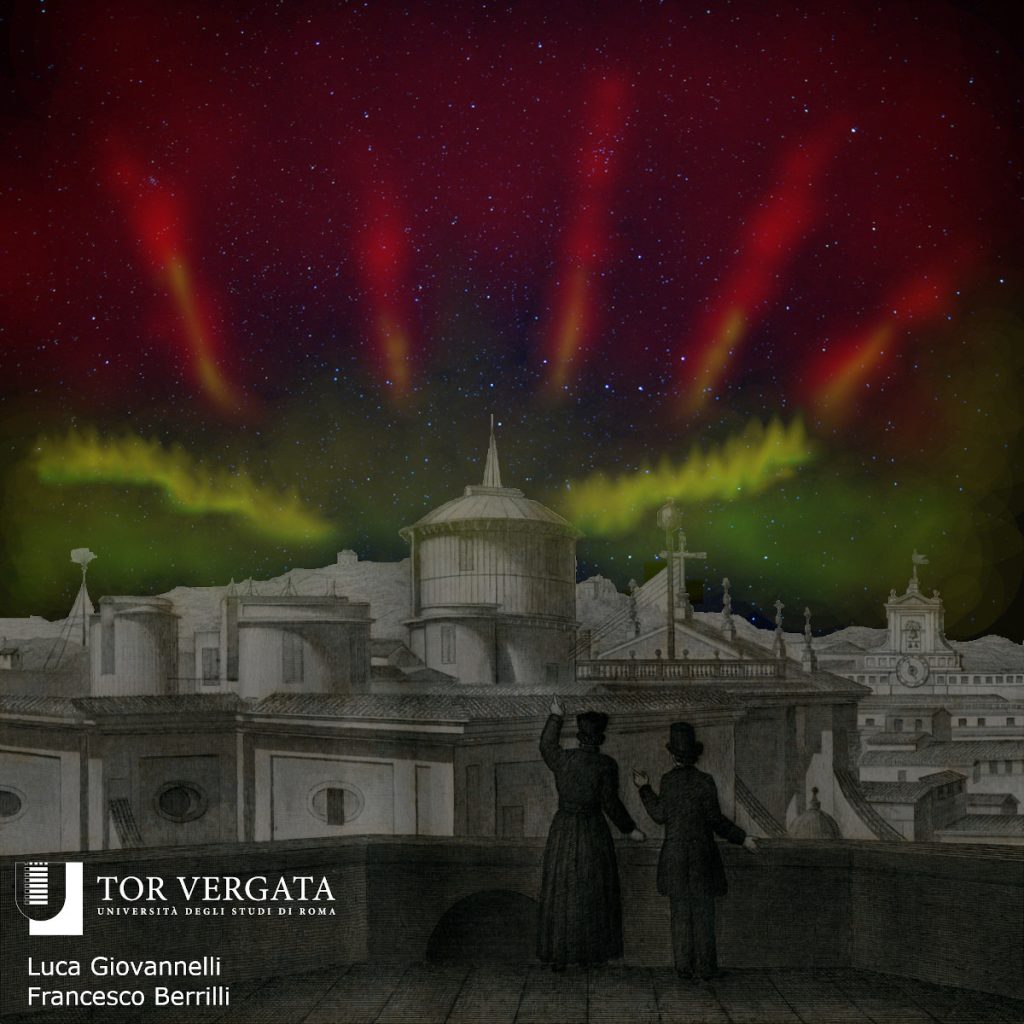
In a recent paper, we describe the main results of the observations and studies carried out by Angelo Secchi at the Observatory of the Roman College and described in his “Memoria sull’Aurora Elettrica del 4 Febbraio 1872” for the Notes of the Pontifical Academy of new Lincei.
Publication: Berrilli F., Giovannelli L., 2021, Journal of Space Weather and Space Climate, vol. 12. https://www.swsc-journal.org/articles/swsc/full_html/2022/01/swsc210083/swsc210083.html
On the link between the topside ionospheric effective scale height and the plasma ambipolar diffusion, theory and preliminary results
Papers from SWICo members
A. Pignalberi, M. Pezzopane, B. Nava, P. Coïsson
Over the years, an amount of models relying on effective parameters were implemented in the challenging issue of the topside ionosphere description. These models are based on different analytical functions, but all of them depend on a parameter called effective scale height, that is deduced from topside electron density measurements. As their names state, they are effective in reproducing the topside electron density profile only when applied to the analytical function used to derive them. Then, in principle, they do not have any physical meaning. It is the goal of this paper to mathematically link the effective scale height modeled through the Epstein layer to the vertical scale height theoretically deduced from the plasma ambipolar diffusion theory.
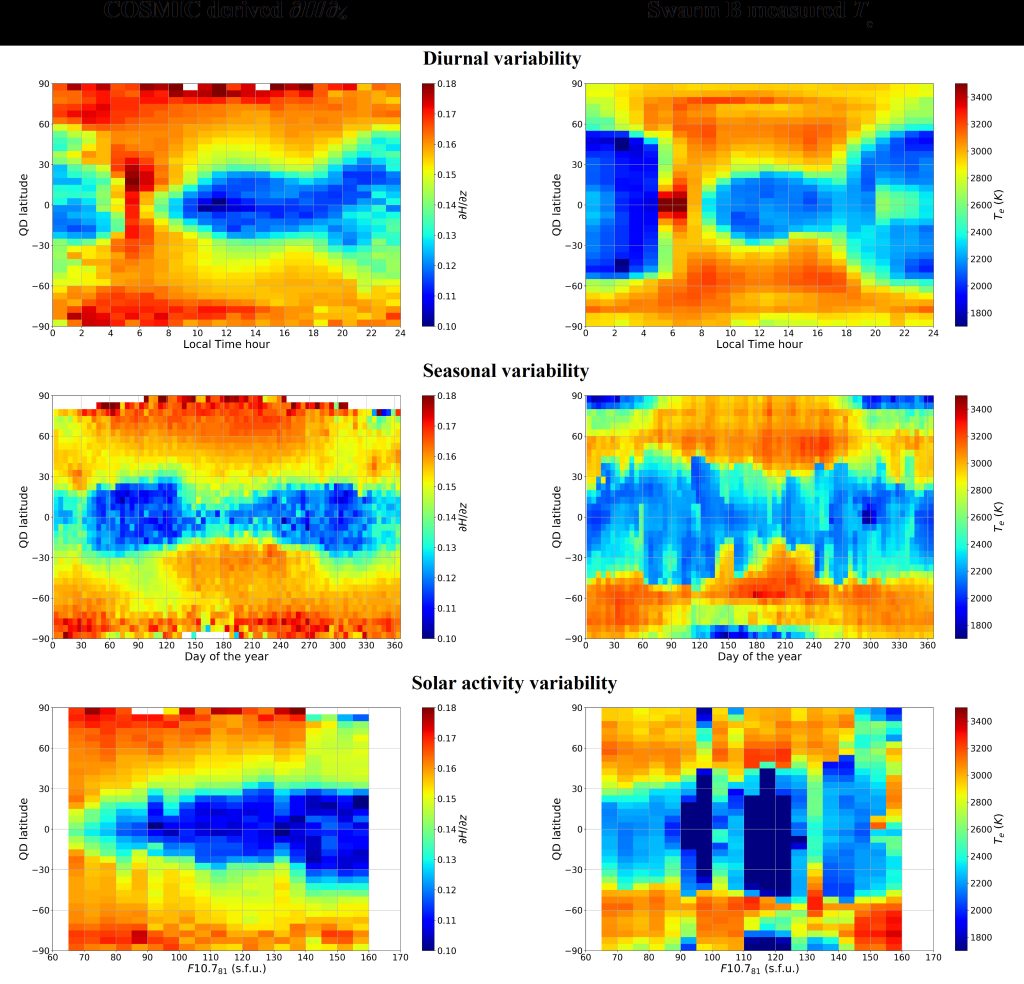
Firstly, effective and theoretical scale heights are linked through a mathematical relation by showing that they tend to each other in the topside ionosphere. Secondly, their connection is preliminarily demonstrated by calculating effective scale height values from the entire COSMIC/FORMOSAT-3 radio occultation dataset. Thirdly, a possible connection between the vertical gradient of the topside scale height (as obtained by COSMIC/FORMOSAT-3 satellites) and the electron temperature (as obtained by ESA Swarm B satellite) is studied by highlighting corresponding similarities in the diurnal, seasonal, solar activity, and latitudinal variability.
Publication: A. Pignalberi, M. Pezzopane, B. Nava, P. Coïsson, On the link between the topside ionospheric effective scale height and the plasma ambipolar diffusion, theory and preliminary results, Scientific Reports 10:17541, 2020. https://doi.org/10.1038/s41598-020-73886-4
Ionospheric Turbulence and the Equatorial Plasma Density Irregularities: Scaling Features and RODI
Papers from SWICo members
P. De Michelis, G. Consolini, R. Tozzi, A. Pignalberi, M. Pezzopane, I. Coco, F. Giannattasio, and M.F. Marcucci
Equatorial plasma bubbles are ionospheric irregularities that usually occur after sunset and are characterized by strong density depletions. At the edges and inside the bubbles plasma turbulence processes are thought to take place, that are able to perturb electromagnetic signals crossing these regions, such as for example those from GNSS satellites. We investigated the relationship between the Rate Of change of electron Density Index (RODI) and the scaling features of the electron density during plasma bubbles crossings, as identified by 22 months of data of the Swarm A spacecraft (2014-2016).
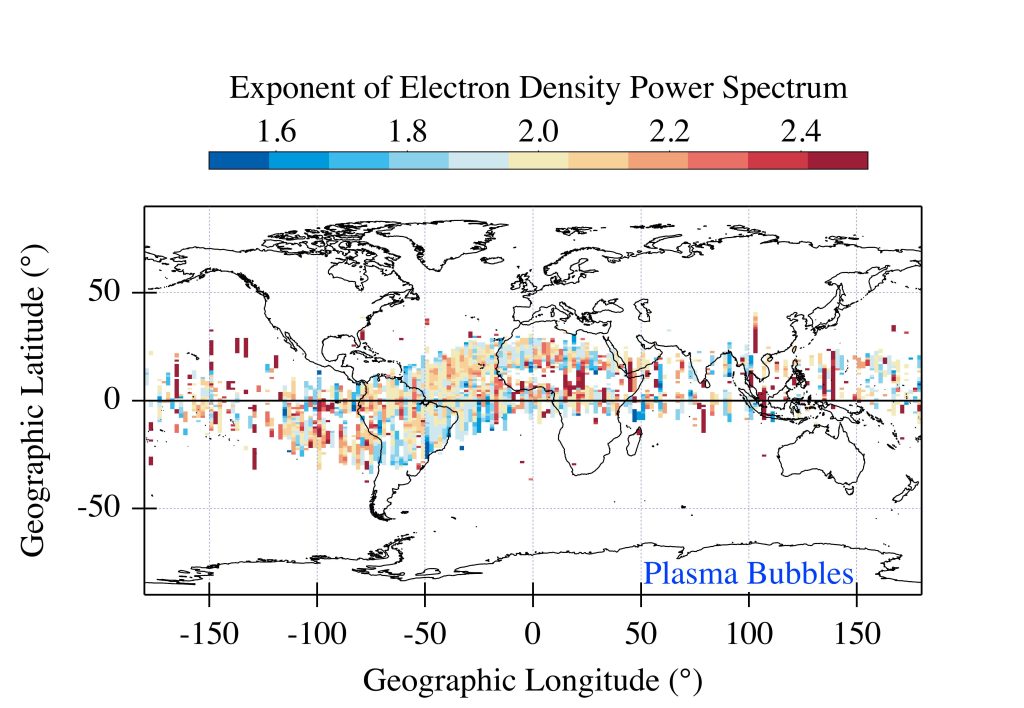
We found that plasma bubbles exhibit scaling properties, which are completely different from the surrounding environment and are associated with large density gradients. These large density gradients, which are certainly the result of the turbulent nature of the irregularities, are reflected in high RODI values. Therefore, RODI could be used as a proxy of those ionospheric irregularities which are characterized by a turbulent nature.
Publication: P.De Michelis, G. Consolini, R. Tozzi, A. Pignalberi, M. Pezzopane, I. Coco, F. Giannattasio, M. F. Marcucci, Ionospheric Turbulence and the Equatorial Plasma Density Irregularities: Scaling Features and RODI, Remote Sens., 13, 759, 2021. https://doi.org/10.3390/rs13040759
Looking for a proxy of the ionospheric turbulence with Swarm data
Papers from SWICo members
P. De Michelis, G. Consolini, A. Pignalberi, R. Tozzi, I. Coco, F. Giannattasio, M. Pezzopane, and G. Balasis.
We selected about four years (April 2014-February 2018) of 1 Hz electron density measurements recorded on-board ESA Swarm A satellite, and we identified two different geomagnetic conditions according to the Auroral Electrojet (AE) index: quiet (AE<50 nT) and active (AE>300 nT). For both datasets, we evaluated the first- and second-order scaling exponents and an intermittency coefficient associated with the electron density fluctuations. Then, the joint probability distribution between each of these quantities and the rate of change of electron density index (RODI) was also evaluated.
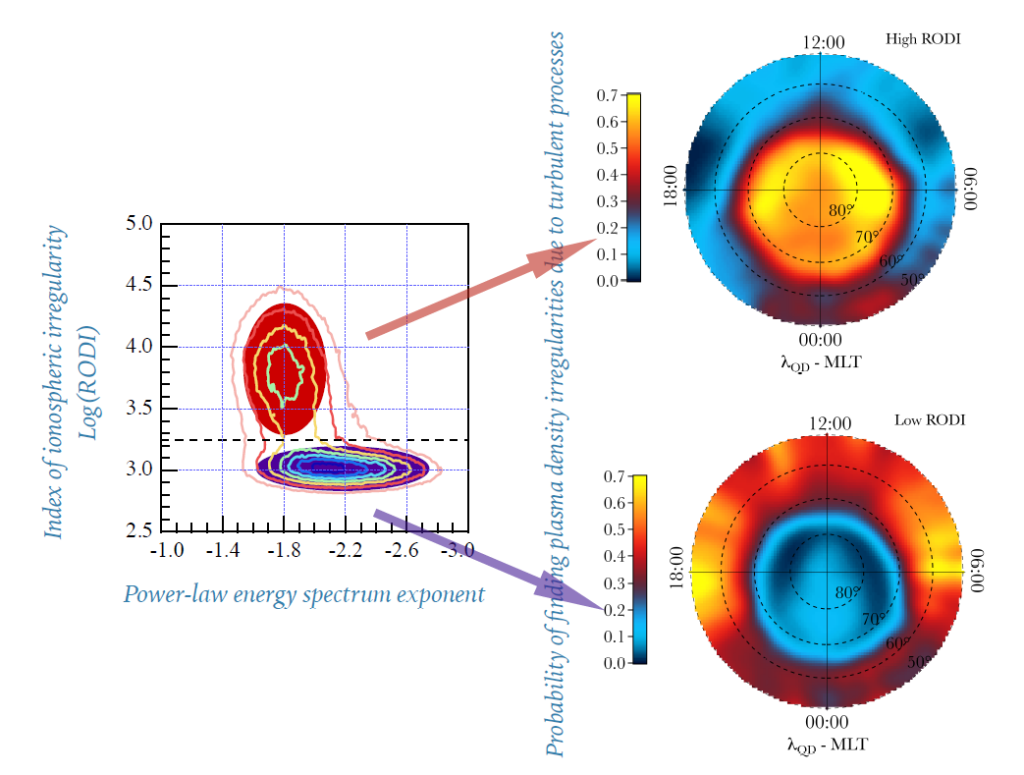
We identified two families of plasma density fluctuations characterized by different mean values of both the scaling exponents and RODI, suggesting that different mechanisms (instabilities/turbulent processes) can be responsible for the observed scaling features. Furthermore, a clear different localization of the two families in the magnetic latitude – magnetic local time plane is found and its dependence on geomagnetic activity levels is analyzed. These results may well have a bearing about the capability of recognizing the turbulent character of irregularities using a typical ionospheric plasma irregularity index as a proxy.
Publication: P. De Michelis, G. Consolini, A. Pignalberi, R. Tozzi, I. Coco, F. Giannattasio, M. Pezzopane, and G. Balasis, Looking for a proxy of the ionospheric turbulence with Swarm data, Scientific Reports, 11, 6183, 2021. https://doi.org/10.1038/s41598-021-84985-1
High-latitude polar pattern of ionospheric electron density: Scaling features and IMF dependence
Papers from SWICo members
G. Consolini, R. Tozzi, P. De Michelis, I. Coco, F. Giannattasio, M. Pezzopane, M.F. Marcucci, and G. Balasis.
We used electron density measurements over a period of 15 months from April 1, 2014 to June 30, 2015, from ESA Swarm A satellite, and computed the related 1st and 2nd order scaling exponents of the q-th order structure function.
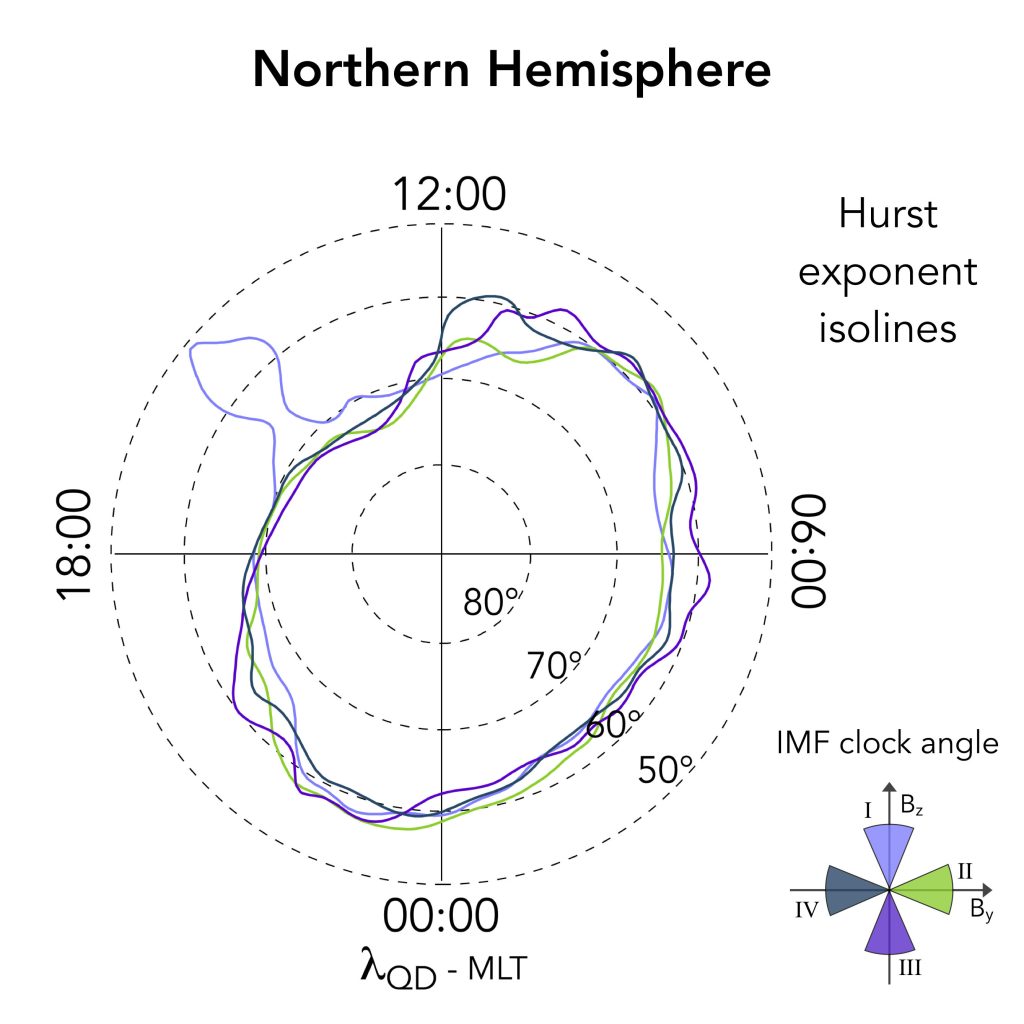
We mapped them as a function of magnetic latitude and local time for four main orientations of the Interplanetary Magnetic Field under conditions of high solar activity (average solar radio flux – F10.7 – index equal to 140 ± 30 sfu, during the considered period). On the whole, the found patterns of the electron density 1st and 2nd order scaling exponents suggest the occurrence of turbulence at the high latitudes.
Publication: G. Consolini, R. Tozzi, P. De Michelis, I. Coco, F. Giannattasio, M. Pezzopane, M.F. Marcucci, and G. Balasis, High-latitude polar pattern of ionospheric electron density: Scaling features and IMF dependence, Journal of Atmospheric and Solar-Terrestrial Physics, 2021. https://doi.org/10.1016/j.jastp.2020.105531
Parallel electrical conductivity in the topside ionosphere derived from Swarm measurements
Papers from SWICo members
F. Giannattasio, P. De Michelis, A. Pignalberi, I. Coco, G. Consolini, M. Pezzopane, and R. Tozzi.
About four years of plasma data (electron density and temperature) from the ESA Swarm A satellite has been used to compute the ionospheric electrical conductivity parallel to the geomagnetic field, with the purpose of climatologically characterize a fundamental parameter involved in the formation and evolution of the field aligned currents. Variations as a function of magnetic latitude, local time and season are examined and the average effect of particle precipitation is evaluated by subtraction of the background conductivity by using the IRI model.
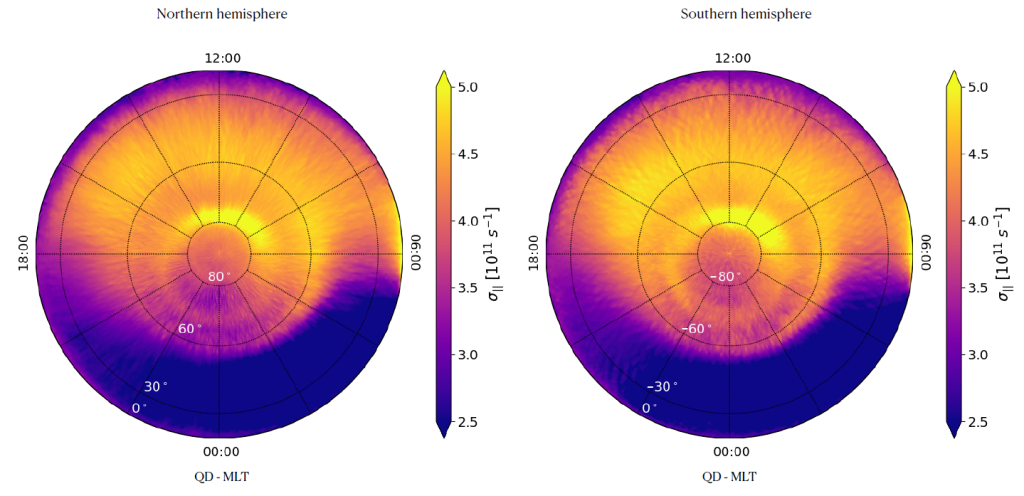
The results overall agree with previous literature, but also evidence interesting unexpected features, such as, for examples, marked asymmetries in the conductivity distributions between Northern and Southern hemispheres.
Publication: F. Giannattasio, P. De Michelis, A. Pignalberi, I. Coco, G. Consolini, M. Pezzopane, and R. Tozzi, Parallel electrical conductivity in the topside ionosphere derived from Swarm measurements, J. Geophys. Res.: Space Physics, 126(2), e2020JA028452, 2021. https://doi.org/10.1029/2020JA028452.
The ESA Swarm mission to help ionospheric modeling: a new NeQuick topside formulation for mid-latitude regions
Papers from SWICo members
M. Pezzopane and A. Pignalberi.
The ionospheric topside representation made by the NeQuick model is improved by correcting the H0 parameter. This task is accomplished by fitting the NeQuick topside analytical function through the F2-layer absolute electron density maximum and the electron density value as measured by Swarm satellites from December 2013 to September 2018. The new NeQuick formulation is statistically validated by comparing modeled values to those derived from COSMIC/FORMOSAT-3 measured Radio Occultation profiles, and those measured by Swarm satellites.
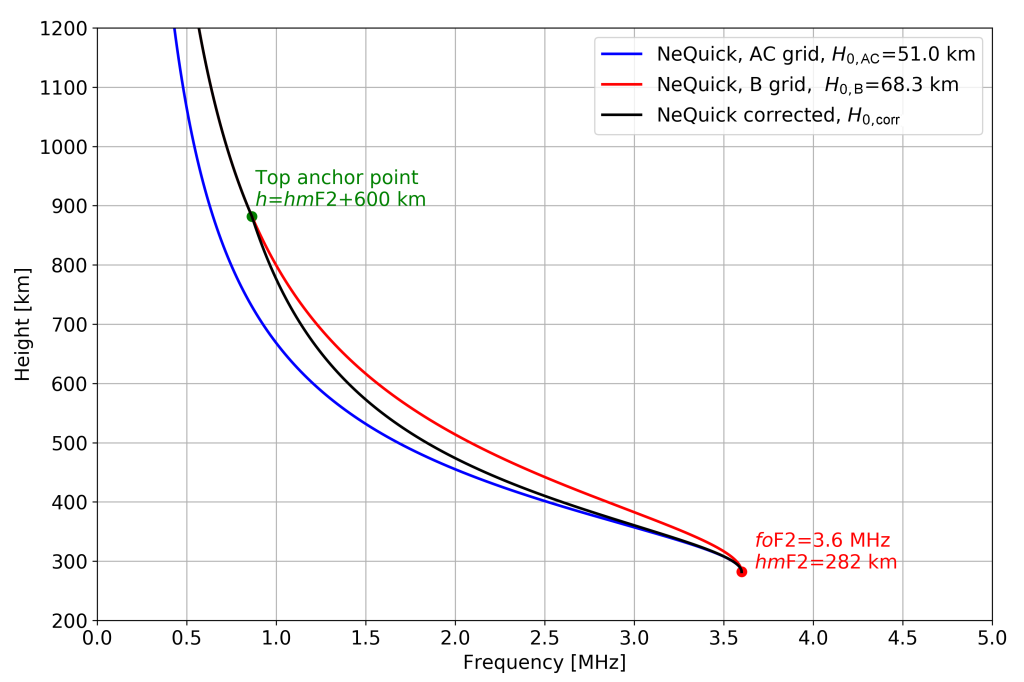
The results show that the proposed formulation is reliable and significantly improves the topside description made by the NeQuick model at mid latitudes, for both high and low solar activities. This means that this new formulation might be proposed as an additional topside option for the International Reference Ionosphere model.
Publication: M. Pezzopane and A. Pignalberi, The ESA Swarm mission to help ionospheric modeling: a new NeQuick topside formulation for mid-latitude regions, Scientific Reports, 9, 12253, 2019. https://doi.org/10.1038/s41598-019-48440-6
Maximum usable frequency and skip distance maps over Italy
Papers from SWICo members
M. Pietrella and M. Pezzopane.
This work describes how MUF and skip distance maps are generated combining the Simplified Ionospheric Regional Model (SIRM) and its UPdated version (SIRMUP) with the Lockwood algorithm. Climatological maps are generated every hour considering the predicted 12-months smoothed sunspots number. Nowcasting maps are instead generated every 15 min exploiting foF2 and M(3000)F2 data measured at the ionospheric stations of Rome and Gibilmanna.
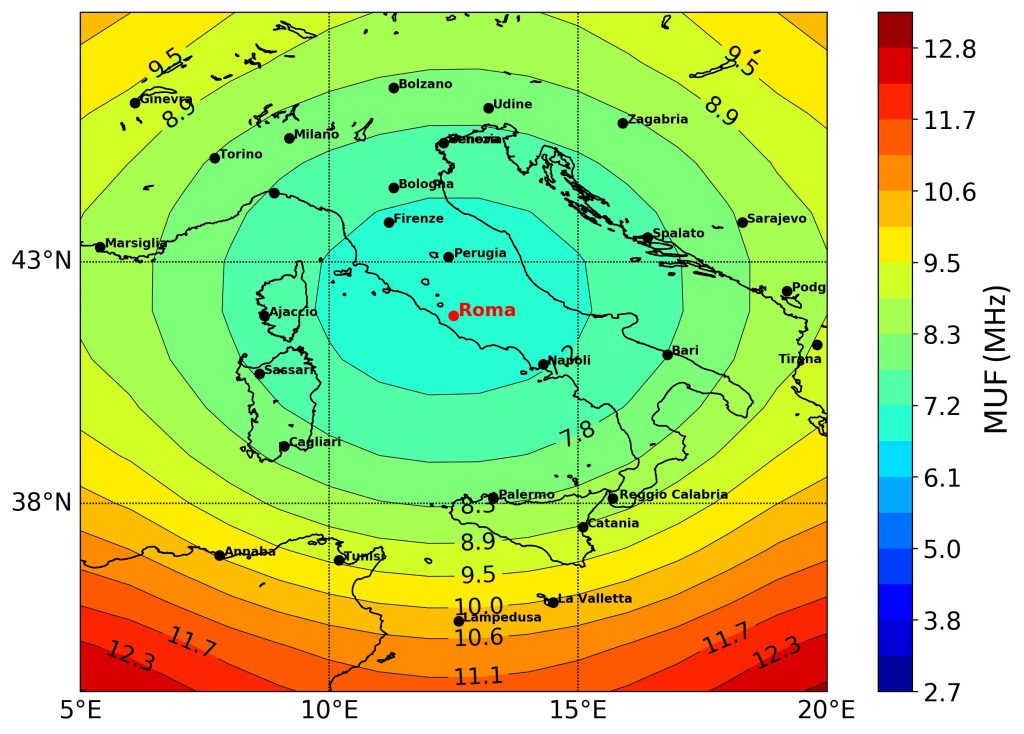
Nowcasting maps constitute the most important novelty because they let High Frequency (HF) users know in quasi real-time the radio propagation conditions over Italy. This is really important in terms of reliable radio links, especially in case of adverse space weather events.
Publication: M. Pietrella and M. Pezzopane, Maximum usable frequency and skip distance maps over Italy, Adv. Space Res., 66(2), 243, 2020. https://doi.org/10.1016/j.asr.2020.03.040
